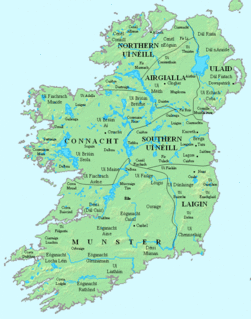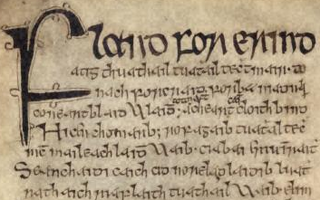Diarmait mac Máel na mBó was King of Leinster, as well as High King of Ireland. He was one of the most important and significant kings in Ireland in the pre-Norman era. His influence extended beyond the island of Ireland into the Hebrides, the Isle of Man, Wales, and even into England.
Lóegaire (died c. 462), also Lóeguire, is said to have been a son of Niall of the Nine Hostages. The Irish annals and king lists include him as a King of Tara or High King of Ireland. He appears as an adversary of Saint Patrick in several hagiographies. His dealings with the saint were believed to account for his descendants' lack of importance in later times. There are several accounts of his death, all of which contain supernatural elements, some of which concern his wars against Leinster.

Domhnall Ua Lochlainn, also known as Domhnall Mac Lochlainn, claimed to be High King of Ireland.
Toirdhealbhach Ua Briain, anglicised Turlough O'Brien, was King of Munster and effectively High King of Ireland. A grandson of Brian Bóruma, Toirdelbach was the son of Tadc mac Briain who was killed in 1023 by his half-brother Donnchad mac Briain.
The Laigin, modern spelling Laighin, were a population group of early Ireland. They gave their name to the province of Leinster, which in the medieval era was known in Irish as Cóiced Laigen, meaning "province of the Leinstermen". Their territory, located in south-east Ireland, is thought to have once extended from the River Shannon to the River Boyne.
Áed mac Néill, commonly called Áed Oirdnide, was King of Ailech. A member of the Cenél nEógain dynasty of the northern Uí Néill, he was the son of Niall Frossach. Like his father, Áed was reckoned High King of Ireland. He was King of Ailech from 788 onwards and High King of Ireland from 797.

Donnchad mac Domnaill, called Donnchad Midi, was High King of Ireland. His father, Domnall Midi, had been the first Uí Néill High King from the south-central Clann Cholmáin based in modern County Westmeath and western County Meath, Ireland. The reigns of Domnall and his successor, Niall Frossach of the Cenél nEógain, had been relatively peaceful, but Donnchad's rule saw a return to a more expansionist policy directed against Leinster, traditional target of the Uí Néill, and also, for the first time, the great southern kingdom of Munster.
Muiredach mac Brain was a King of Leinster of the Uí Dúnchada sept of the Uí Dúnlainge branch of the Laigin. This sept had their royal seat at Líamhain. He was the son of Bran mac Fáeláin and brother of Ruarc mac Brain, previous kings.
Báetán mac Cairill,, was king of the Dál Fiatach, and high-king of Ulaid, from c. 572 until his death. He was the son of Cairell mac Muiredaig Muinderg and brother of Demmán mac Cairill, previous Kings of Ulaid. According to some sources, he was high-king of Ireland.
Domnall mac Áedo, also known as Domnall II, was a son of Áed mac Ainmuirech. Domnall was High King of Ireland from 628 until his death. He belonged to the Cenél Conaill kindred of the Northern Uí Néill.

Flann Sinna was the son of Máel Sechnaill mac Máele Ruanaid of Clann Cholmáin, a branch of the southern Uí Néill. He was King of Mide from 877 onwards and is counted as a High King of Ireland. His mother Land ingen Dúngaile was a sister of Cerball mac Dúnlainge, King of Osraige.
Mac Cairthinn mac Coelboth (?-446?-530?) was an Uí Enechglaiss King of Leinster.
Fergnae mac Óengusso Ibdaig was a Dal Fiatach king of Ulaid. He was the nephew of Muiredach Muinderg mac Forgo and grandson of Forga mac Dallán, previous kings.
Blácaire mac Gofraid was a Viking leader who ruled Dublin in the 10th century. He succeeded his brother Amlaíb mac Gofraid as king in 939 after the latter left Dublin to rule Northumbria. In the early years of his reign Blácaire led raids on important Christian sites at Clonmacnoise and Armagh, but repeated attacks by the Irish of Leinster in 943 and 944 led to the sack of Dublin. A year later Blácaire was replaced as King of Dublin by his cousin Amlaíb Cuarán, who had succeeded Blácaire's brother in Northumbria in 941, but had been driven out in 944.
Crimthann mac Énnai was a King of Leinster from the Uí Cheinnselaig sept of the Laigin. He was the son of Énnae Cennsalach, the ancestor of this dynasty.
Fland Dá Chongal or Flann Ua Congaile was a king of the Uí Failge, a Laigin people of County Offaly.
Bruidge mac Nath Í was a king of the Uí Failge, a Laigin people of County Offaly. He was the grandson of Failge Berraide, the eponymous ancestor of the dynasty.
Áed Rón mac Cathail was a king of the Uí Failge, a Laigin people of County Offaly. He was the grandson of Bruidge mac Nath Í, a previous king.






